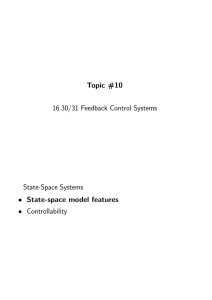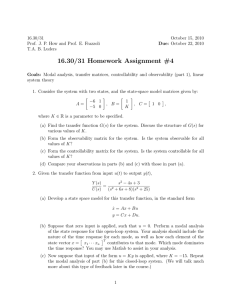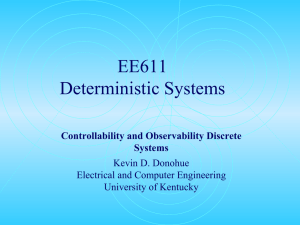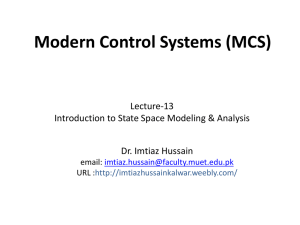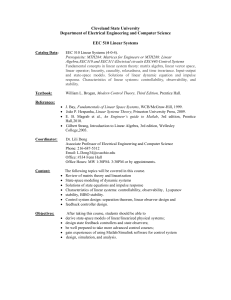T3: Controllability and Observability Introduction
advertisement
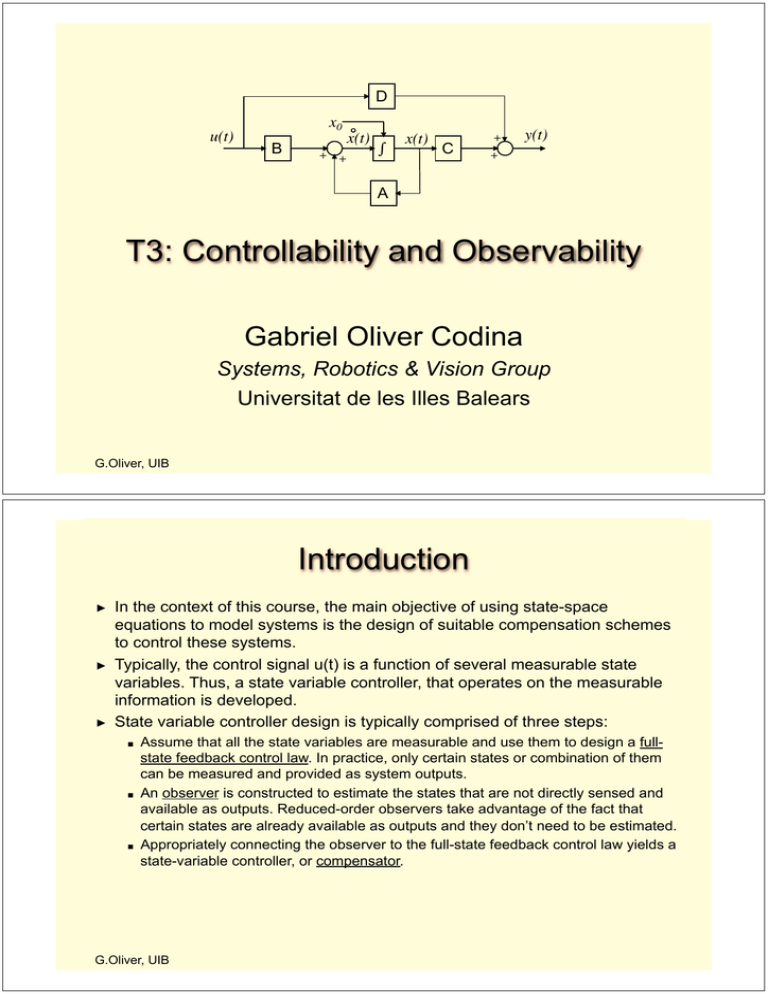
u(t) x0 x(t) + + x(t) + y(t) + T3: Controllability and Observability Gabriel Oliver Codina Systems, Robotics & Vision Group Universitat de les Illes Balears G.Oliver, UIB Introduction In the context of this course, the main objective of using state-space equations to model systems is the design of suitable compensation schemes to control these systems. Typically, the control signal u(t) is a function of several measurable state variables. Thus, a state variable controller, that operates on the measurable information is developed. State variable controller design is typically comprised of three steps: Assume that all the state variables are measurable and use them to design a fullstate feedback control law. In practice, only certain states or combination of them can be measured and provided as system outputs. An observer is constructed to estimate the states that are not directly sensed and available as outputs. Reduced-order observers take advantage of the fact that certain states are already available as outputs and they don’t need to be estimated. Appropriately connecting the observer to the full-state feedback control law yields a state-variable controller, or compensator. G.Oliver, UIB Controllability and Controllability matrix Definition: A control system is said to be (completely) controllable if, for all initial times t0 and all initial states x(t0), there exists some input function u(t) that drives the state vector x(t) to any final state at some finite time t0 t T. CONTROLLABILITY TEST Given a system defined by the linear state equation the controllability matrix is defined as: It can be proved that a system is controllable if and only if: For the general multiple-input (m) case, A is an n x n matrix and B is n x m. Then, P consists of n matrix blocks B, AB, A2B …An-1B, each with dimension n x m, stacked side by side. Thus, P has dimension n x n·m, having more columns than rows. For the single-input case, B consists of a single column, yielding a square n x n controllability matrix P. Therefore, a single-input linear system is controllable if and only if the associated controllability matrix P is nonsingular. (|P|0) G.Oliver, UIB Controllability matrix The rank of an m x n matrix A is one of the following: The maximal number of linearly independent columns of A The maximal number of linearly independent rows of A The size of the largest nonsingular submatrix that can be extracted from A Exercise Prove that the following system is controllable: This result is independent of the characteristic polynomial coefficients a2, a2, a0 Repeat the test for: G.Oliver, UIB Controllability matrix Matlab functions: ctrb() calculates the controllability matrix for state-space systems. Syntax P=ctrb(sys) P=ctrb(sys.A,sys.B) or P=ctrb(A,B) rank() provides an estimate of the number of linearly independent rows or columns of a full matrix. Syntax k = rank(A) Try with: G.Oliver, UIB Coordinate transformations and Controllability Controllability is invariant with respect to state coordinate transformations This property can be tested, for example, with the S-S equations: and the transformed state defined by: Some system properties become obvious when state variables are properly chosen. A convenient form is the diagonal canonical form (DCF). Assuming that the state equation has a single input and that the system dynamics matrix A is diagonalizable, the new equations in DCF can be obtained. Thus, for any integer k 0, it is easy to obtain: G.Oliver, UIB Coordinate transformations and Controllability Thus, the controllability matrix is nonsingular if and only if each factor on the right-hand side is nonsingular Nonsingular bi0 i Vandermonde matrix ALTERNATE TEST OF CONTROLLABILITY Since controllability is invariant with respect to state coordinate transformations, a necessary and sufficient condition for controllability is that the eigenvalues of A (diagonal elements of ADCF) must be distinct and every element of BDCF must be nonzero. G.Oliver, UIB Controllable Realizations of the same Transfer Function Two controllable n-dimensional single-input, single-output realizations of the same transfer function: are related by a unique state coordinate transformation x1(t)=Tx2(t). It can be shown that T is defined as: G.Oliver, UIB Observability In state-space description of linear time-invariant systems, the state vector x(t) is an internal quantity that is influenced by the input u(t) and affects the output y(t). In practice, the dimension of x(t) is greater than the number of inputs or output signals. The question stated now is whether or not the initial state can be uniquely determined by measurements of the input and output signals of the linear s-s equation over a finite time interval. If so, initial state and input signal can be injected to the state equation solution formula to reconstruct (predict) the entire state trajectory. Definition: Given a LTI system that is described by the state x(t0) is said to be observable if given any input u(t), there exists a finite time T t0 such that the knowledge of signal input u(t), signal output y(t) for T > t t0, and matrices A, B, C and D, are sufficient to determine x(t0). If every state of the system is observable, the system is said to be (completely) observable. G.Oliver, UIB Observability matrix OBSERVABILITY TEST Given a system defined by its linear state equation, the observability matrix is defined as: It can be proved that a system is observable if and only if: For the general multiple-output (p) case, A is an n x n matrix and C is p x n. Then, Q consists of n matrix blocks C, CA, CA2 …CAn-1, each with dimension p x n, stacked one on top of another. Thus, Q has dimension np x n, having more rows than columns. For the single-output case, C consists of a single row, yielding a square n x n observability matrix Q. Therefore, a single-output linear system is observable if and only if the associated observability matrix Q is nonsingular. (|Q|0) As it happens for the Controllability, the Observability is invariant with respect to coordinate transformation. G.Oliver, UIB Observable Realizations of the same Transfer Function Two observable n-dimensional single-input, single-output realizations of the same transfer function are related by a unique state coordinate transformation x1(t)=Tx2(t), where: Matlab function: obsv() calculates the obsevability matrix for state-space systems. Syntax Q=obsv(sys) Q=obsv(A, C) or Q=obsv(sys.A, sys.C) G.Oliver, UIB Controllability and Observability examples Given the system shown below, determine its controllability and observability T3_Contr_Observ.m Study the controllability and observability of the following magnetic ball suspension system: Magnetic force Motion equation Electric circuit equ i: winding current y: ball vertical position L: winding inductance k: positive constant factor R: winding resistance v: input voltage G.Oliver, UIB y g: gravitational acceleration M: ball mass
